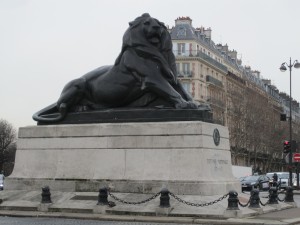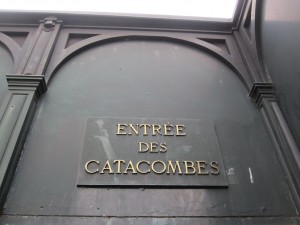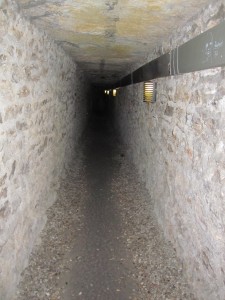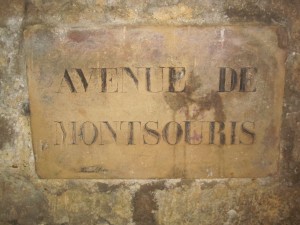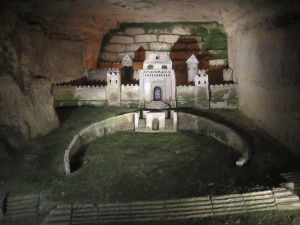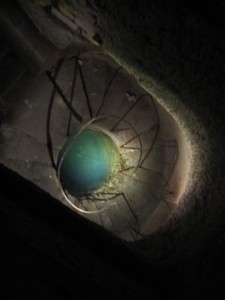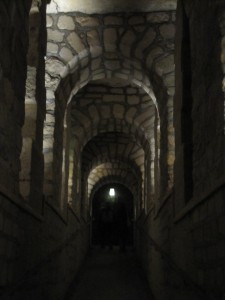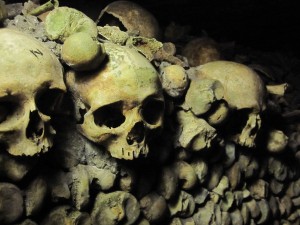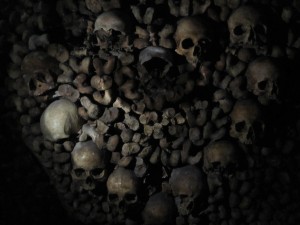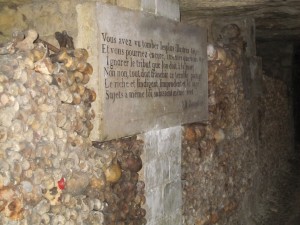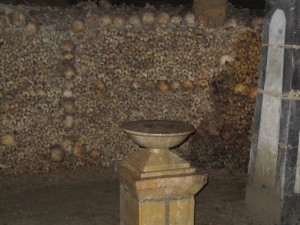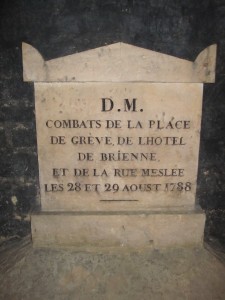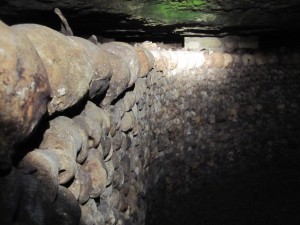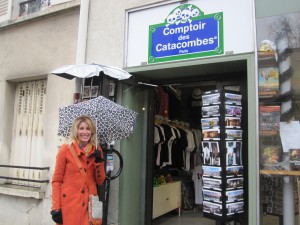NOTE: As of January 17, 2012, I have moved my blog to my new website: www.onegirlsadventures.com
I will still be doing duplicate posts on this website for the next 6 months or so, but plan to close it down after that. I am hoping you can go to my new website and subscribe!!
MERCI BEAUCOUP!
*****
*****
While my camel continues to wander the deserts of Blogland nameless (see my last post if you are scratching your head right now), I decided to visit the bones of over 6 million Parisian residents in the Paris Catacombs. Yep, that is right, 6 million skeletons...and most are elegantly stacked and artfully presented like only the French would think to do.
However, I learned today that the bones weren't always so well organized nor were the catacombs, originally an old limestone and gypsum mine, the first place of rest for most of the quiet inhabitants. Over the course of 3 hours and a 2km walk, I discovered for myself the interesting history of a small segment of this underworld which stretches for miles and miles and whose history dates back to the 12th century.
The Lion of Belfort in Place Denfert Rochereau guarding the entrance to the Catacombs!
I entered the catacombs via the tourist entrance on Avenue René Coty in the 14eme arrondissement. Had I perhaps been feeling above the law (entrance into the catacombs became illegal in 1955) or not wanting to rent the 3 Euro Audioguide :), I would have found a more clandestine entrance to the subterranean maze joining the ranks of other off-beat adventurers, mysterious vagabonds and renegade artists. Next time!
At the end of the 18th century, when the catacombs were first selected to serve as an ossuary, they were situated just outside of the city limits. Uh, that is not the case today! The 30 minute walk from my apartment took me down the busy Rue Raspail past bustling cafes, gorgeous Haussmannian buildings and monument-dotted places... clearly a much different site than the sparsely populated suburbia that would have been here just over 200 years ago.
These are the narrow limestone-walled corridors that I winded through during the first part of the visit. They are original to the mine and reinforced in the 18th century...thank goodness!
I descended 130 steps to a depth of 20 meters below Paris' surface. Here I was below the sewer systems, water pipes and all metro tunnels. I landed in a well- lit room with wall-displays summarizing the near 1000 year history of the quarries. Since the 12th century, limestone from these mines was used to build the likes of Notre Dame and the Louvre. In 1777, after major accidents that caused streets to cave-in and Parisiens to die, a Royal Council was created and a major reinforcement project was started as a means to protect the mines and the city above. It was in 1785 that the les carrières de Paris took on a whole new purpose.
Just a brief history of why the catacombs/ossuary exist today...
Starting in the 10th century, Paris buried their dead at the local church cemeteries. The Cimentiere des Saints-Innocents in today's Les Halles district (1eme arrondissement) was the largest. And after nearly 700 years of burials there (and without the ability to expand in its urban setting) the cemetery became overwhelmed. Health and sanitary conditions for the residents around Les Halles became unbearable and deadly. Due to public outcry, Saints-Innocents was closed in 1780 and King Louis XVI was asked to come up with a solution. Five years later, working at the expected speed of a government official, it was determined that all human remains would be removed from Paris cemeteries and deposited in the quarries.
For decades, priests could be seen at night leading processions of bone-filled carts covered in black veils into the mines. They were spread chaotically at first on the quarry floors. It wasn't until 1810 that they began being stacked in their more celebrated presentation of today.
An an example of the bountiful wall inscriptions in the quarries that helped keep workers oriented with the world above.
Before arriving at the ossuary portion of the quarries, I weaved through over a kilometer of dark, damp limestone pathways. Sprucing up the otherwise mundane walls from time to time were inscriptions either noting the old name of the street above me (Avenue de Montsouris does not exist today) or letter and number formulas indicating the year a particular section had been reinforced and the initials of the engineer who led the effort. It was nice seeing a lot of those inscriptions!
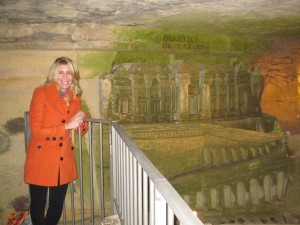
The first surprise down in the catacombs was a wonderful miniature sculpture of a fortress from the island of Minorca. It was created by a quarryman named Dècure during the reinforcement work effort that started in 1777. While other workers would go to the surface to eat, drink and rest, Dècure would stay down in the quarries working on his limestone memoirs (he was a member of Louis XV's army and was believed to have been held prisoner on the island by the English). The horrible part of his story is that once he completed the sculptures and started working on a staircase for people to come down to enjoy them, a part of the quarry collapsed and killed him! *sigh* Nothing like a sad tale to get you in the mood to see a bunch of dead people. :( Notice in the above picture how I am trying to look as lively as possible...I don't want to be mistaken for one of the 6 million permanent residences down here!
Another one of Dècure's beautiful, intricate sculptures.
Following the limestone brick road...
A well deep in the catacombs with water so clear that workman would once fill their buckets with it and think they were empty...looks a bit more murkier now :).
At the top of this magnificent arched walkway was the entrance to the ossuary. Cue scarey-music track :)
And then, je suis arrivé!
Above the entrance framed by two stone pillars with simple geometric shapes, was a cautionary engraving ...
"ARRÊTE, C'EST ICI L'EMPIRE DE LA MORT"
(Stop! This is the empire of death!)
I entered.
My first glimpse of the stacked bones.
I was surrounded! And I would be for the next 783 meters of my walk. I don't think I was prepared for that many skulls and femurs...really.Skulls in a shape of a heart. Clever.
No one has a headstone. In these halls, famous and common, rich and poor, all are anonymous and all lay peacefully together. However, when I descended there was a list of the prominent French buried in the catacombs. The one that stood out most to me was: L'homme au masque de fer, décédé 1703 (The man in the iron mask, deceased 1703). I also found it interesting that the engineer who originally led the quarry reinforcement and ossuary projects, Alexandre Lenoir, was among the unidentified.
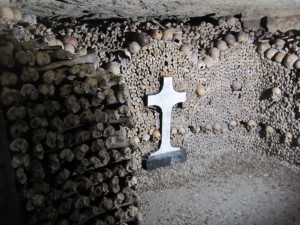
One of the many decorative details in the catacombs.
Beginning in 1785, the catacombs were at first just a bone repository. It wasn't until 1810 that Héricart de Thury, a new General Inspector of Quarries in the Empire, had the bones all arranged in an orderly fashion. The skulls and long bones were used to create decorative facades while the remaining bones were heaped behind them. Tombstone and cemetery decorations completed the wall of bones along with placards identifying specific parish cemeteries and the date their bones were placed. The ossuary was opened to the public at the beginning of the 19th century...and attracted quite a few folks!
Prior to this picture, I was being beckoned into a dark corner by someone. All I could hear was a, "Psst! Psst!", and all I could see was a shadowy figure with a finger motioning me closer. Uh, Yikesville!! Must walk faster.
The journey through the catacombs was damp and cool...sometimes downright cold. In the heart of it I often found myself all alone. In those moments I did my best to stop, reflect and remember all the lives that these bones represented. To be honest, it got a bit overwhelming. By the time I had completed my walk, I had a full on stomach ache.
The fragility of human life was constantly reinforced in these halls. Plaques like the one above held quotes from authors, poets and The Bible that most often were a reminder of our mortality. Pictured is an excerpt of one of Rosseau's writings.
Here are a few of the quotes I captured:
Si vous avez vu quelque fois mourir une homme, considerez toujours que le mêmes sort vous attend. (If you have seen a man die a few times, always remember that the same fate awaits you.)
Pensez la matin que vous n'irez peut-être pas jusques au soir et au soir que vous n'irez peut-être pas jusques au matin. (Think in the morning that you will not arrive to the evening and in the evening that you will not arrive to the morning.)
Can you understand the stomach ache now!?
The oldest artifact in the Catacombs. This "Sepulchral Lamp," once used by the quarrymen, use to hold a fire. The burning fire created a draft allowing air to circulate in the corridors.
This was one of those corners where it was just me. The water dripping from the ceiling was all that broke the silence....
This monument commemorates victims of a riot that were part of a series of riots that led up to the French Revolution. Those who died in this massacre (as well as 2 others) are among the few people who were ever directly buried in the Catacombs.
Final glimpse of the macabre scene before I headed back to a land I was more familiar with!
I ascended the 83 steps and took a big breath of fresh air! But, drat it all! It was rainy and grey when I walked out onto the small rue next to the exit, so definitely NOT less gloomy then the bone labyrinth I had just completed. I tried to re-coop a more convivial spirit by browsing the toy eyeballs and les petits squelettes (skeleton) magnets in the “Comptior des Catacombes” boutique across the street, but walking back to the metro and then down in it, all I could think about was how everyone I was looking at, the lovers kissing next to me, the tourists studying their maps, the 2 north Africans conversing, me as well as everyone I know, will one day too enter the “empire of the dead.” Okay, time to turn this frown upside down! Cocktails anyone?
I headed to a bar said to have the BEST mojitos in Paris, Pixel Bar in Saint Germain! But, alas, it was closed :(....no note on the door or anything. I hope the bartender didn't die! Oh, I must get these thoughts out of my mind!! Off to bar #2 that is said to have the SECOND BEST mojitos in Paris, L'Atlas, also in Saint Germain (actually I jest...they aren't known for their mojitos or anything for that matter, but their fresh fish display is always lovely which was reason enough to for me to walk in!)
Ah, just what I needed!
I took my spot at the bar and placed my mojito order! My friendly bartender took great care to mix what he hoped I would pronounce as the BEST mojito in Paris. It was delicious. Now I was really returning to the land of the living....and the smile was growing. Enjoying the atmosphere, I ordered a piping hot bowl of the moules-frites (but sans frites). A serveur brought me a beautiful mound of small-shelled mussels drenched in a savory wine sauce. They meat was so delicate and sweet...and as I was declaring this to my bartender he told me they came from Normandy near Mount Saint Michel. Double smile.
These guys found their eternal resting spot in the catacombs of my stomach!
Uh oh, stomach ache again! But this one was not from over-contemplating my morality...no, this one was from over-indulging on the bounties of life. I ate too much! :) Oh well, all too real was today's lesson: one day I literally will be a pile of bones...so might as well put a little meat on them now!
Final Note: Walking to class this morning (2 days after visiting the catacombs), I came upon 3 young men on the street corner. Clad in survival gear including backpacks, flashlights and rubber boots, they were covered in a light cream-colored mud and exchanged excited glances and exhilarated speech. Had they just returned from a jaunt into Paris' underbelly? I think it is highly probable.

